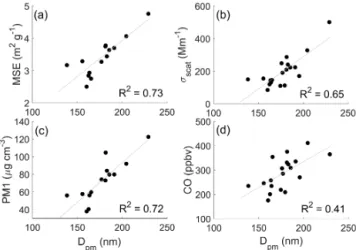Physical and optical properties of aged biomass burning aerosol from wildfires in Siberia and the Western USA at the Mt. Bachelor Observatory
Texto
Imagem




Documentos relacionados
Intra-seasonal variability of smoke aerosol optical depth (AOD) and downwelling solar irradiance at the surface during the 2002 biomass burning season in South Amer- ica was
Positive matrix factorization analysis of the TPOT AMS organic mass spectra yielded a primary biomass burning factor and four oxygenated organic aerosol factors directly..
The direct consequences arise from the physical properties of the pigment (particle size and particle size distribution, surface area) and from the chemical properties
With the exception of the nucleation mode, particle number and volume concentration cycles are very similar to the cycles of aerosol optical properties and mass concentrations..
The Amazon basin seems to be the only location outside Southern Africa where seasonality of the aerosol particle size distribution is dominated by wild fires and biomass burning,
In order to study the role of biomass burning on GHG’s over study site we have analysed GHG’s emissions from biomass burning using long term (2003–2013) Fire Energetics and
M.: Measurement of the mixing state, mass, and optical size of individual black carbon particles in urban and biomass burning emissions, Geophys. F.:
We present a case study of BC wet removal by examining aerosol size distributions and BC coating properties sampled in three Canadian boreal biomass burning plumes, one of which